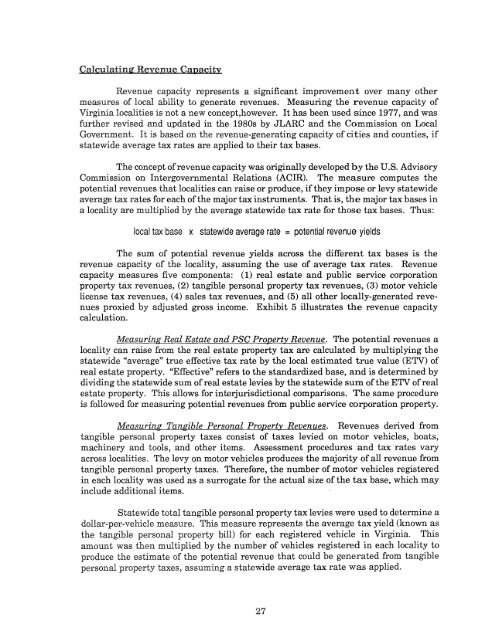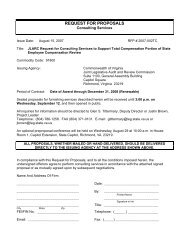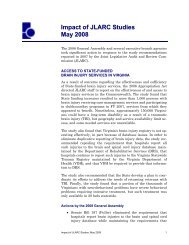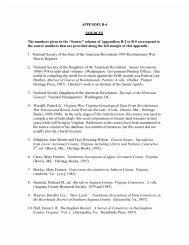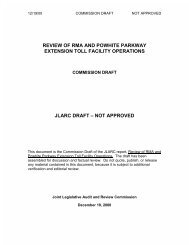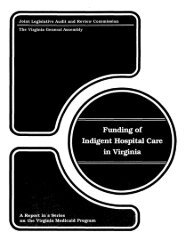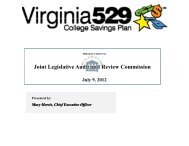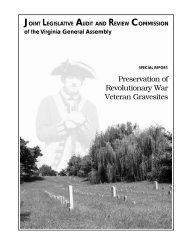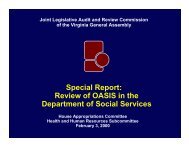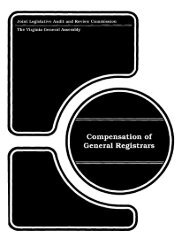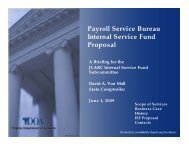Funding of Constitutional Officers - Virginia Joint Legislative Audit ...
Funding of Constitutional Officers - Virginia Joint Legislative Audit ...
Funding of Constitutional Officers - Virginia Joint Legislative Audit ...
You also want an ePaper? Increase the reach of your titles
YUMPU automatically turns print PDFs into web optimized ePapers that Google loves.
Calculating Reyenue Capacity<br />
Revenue capacity represents a significant improvement over many other<br />
measures <strong>of</strong> local ability to generate revenues. Measuring the revenue capacity <strong>of</strong><br />
<strong>Virginia</strong> localities is not a new concept,however. It has been used since 1977, and was<br />
further revised and updated in the 1980s by JLARC and the Commission on Local<br />
Government. It is based on the revenue-generating capacity <strong>of</strong> cities and counties, if<br />
statewide average tax rates are applied to their tax bases.<br />
The concept <strong>of</strong>revenue capacity was originally developed by the U.S. Advisory<br />
Commission on Intergovernmental Relations (ACIR). The measure computes the<br />
potential revenues that localities can raise or produce, ifthey impose or levy statewide<br />
average tax rates for each <strong>of</strong>the major tax instruments. That is, the major tax bases in<br />
a locality are multiplied by the average statewide tax rate for those tax bases. Thus:<br />
local tax base<br />
x statewide average rate = potential revenue yields<br />
The sum <strong>of</strong> potential revenue yields across the different tax bases is the<br />
revenue capacity <strong>of</strong> the locality, assuming the use <strong>of</strong> average tax rates. Revenue<br />
capacity measures five components: (1) real estate and public service corporation<br />
property tax revenues, (2) tangible personal property tax revenues, (3) motor vehicle<br />
license tax revenues, (4) sales tax revenues, and (5) all other locally-generated revenues<br />
proxied by adjusted gross income. Exhibit 5 illustrates the revenue capacity<br />
calculation.<br />
Measuring Real Estate and PSG Property Revenue. The potential revenues a<br />
locality can raise from the real estate property tax are calculated by multiplying the<br />
statewide "average" true effective tax rate by the local estimated true value (ETV) <strong>of</strong><br />
real estate property. "Effective" refers to the standardized base, and is determined by<br />
dividing the statewide sum <strong>of</strong>real estate levies by the statewide sum <strong>of</strong>the ETV <strong>of</strong>real<br />
estate property. This allows for interjurisdictional comparisons. The same procedure<br />
is followed for measuring potential revenues from public service corporation property.<br />
Measuring Tangible Personal Property Revenues. Revenues derived from<br />
tangible personal property taxes consist <strong>of</strong> taxes levied on motor vehicles, boats,<br />
machinery and tools, and other items. Assessment procedures and tax rates vary<br />
across localities. The levy on motor vehicles produces the majority <strong>of</strong>all revenue from<br />
tangible personal property taxes. Theref@re, the number <strong>of</strong>motor vehicles registered<br />
in each locality was used as a surrogate for the actual size <strong>of</strong> the tax base, which may<br />
include additional items.<br />
Statewide total tangible personal property tax levies were used to determine a<br />
dollar-per-vehicle measure. This measure represents the average tax yield (known as<br />
the tangible personal property bill) for each registered vehicle in <strong>Virginia</strong>. This<br />
amount was multiplied by the number <strong>of</strong> vehicles registered in each locality to<br />
,....,.,,,,,11,,,,", the estimate <strong>of</strong> the potential revenue that could be generated from tangible<br />
personal taxes, assuming a statewide average tax rate was applied.<br />
27


